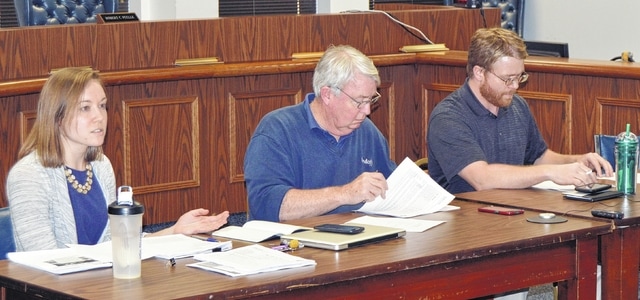
WILMINGTON — Members of Wilmington council’s water committee began talks Tuesday of whether to fluoridate the city’s water.
Water committee chair Kelsey Swindler said two residents brought up the fact that Wilmington is one of few Ohio cities to not fluoridate the water.
One of those residents, Leslie Whitford, spoke at the meeting, saying she never had a cavity until she moved to Wilmington, where she has had three in the past five years.
Swindler said an Ohio Department of Health grant could pay for the startup cost and first year of chemicals to fluoridate the water.
She also presented documents from the Centers for Disease Control, which recommends community water fluoridation as a cost-effective method of reducing tooth decay.
Swindler said she believes council should place the issue on a ballot rather than enact fluoridation as an action of council without citizens’ votes. The committee itself could recommend action, such as placing it on a ballot, to council, which could then debate and vote on the item.
Former Wilmington Council member David Hockaday said a handful of citizens argued against fluoridating water in the past, saying they had allergic reactions to the chemical used in public water systems to add fluoride. Rowlands said over the years he has received a few phone calls from people voicing similar concerns.
Wilmington’s water currently and naturally has a fluoride level of less than 0.2 milligrams per level in 2012, according to an Ohio Department of Health document Swindler provided.
While water systems add fluoride by chemical, fluoride also occurs in rocks and naturally occurs in water. Sabina water, for instance, had a natural fluoride level of 1.32 milligrams per liter in 2012, according to a document provided by the ODH.
Wilmington’s water currently and naturally has a fluoride level of less than 0.2 milligrams per level in 2012, according to an Ohio Department of Health document Swindler provided.
Hockaday also said many countries, particularly in Europe, are opposed to the addition of fluoride to water “because of the health risks and no provable benefits of having fluoride in the water.”
The CDC, which encourages water fluoridation, also refers to a secondary study showing an increase in neurotoxicity to children related to high levels of exposure to fluoride, according to Hockaday.
The News Journal found a study done in 2006 by the National Research Council. That study compared two groups of children living in two Chinese villages. One group of children, exposed to a fluoride level of 4.12 milligrams per liter, had lower intelligence quotient scores. The U.S. Environmental Protection Agency takes action when a fluoride level hits 4.0 milligrams per liter and requires the system to notify those served when it hits 2.0. The CDC currently recommends a concentration of 0.7 milligrams per liter when adding fluoride.
“With those kinds of risks … if you get above 1.4 or closer to 2, you start to have significant health problems,” Hockaday said. “I understand the benefits to the children, I understand the benefits to adults, but you also have many other opportunities to have your fluoride elevated,” such as through the use of dental products.
Swindler said she’d research the CDC report Hockaday alluded to and reach out to the Autism Speaks organization to see if there are health risks there.
Historically, in 1969, ODH mandated that all public water systems serving more than 5,000 people fluoridate their water, giving them one chance to exempt themselves by a ballot issue. Wilmington Safety and Service Director Brian Shidaker said the voters turned out 701-429 against the issue in a special election.
Shidaker said he has spoken with the mayor and the city’s administration isn’t going to take a position on it but would provide information as requested.
Reach Nathan Kraatz at 937-382-2574, ext. 2510 or on Twitter @NathanKraatz.


